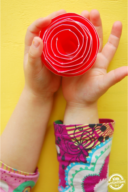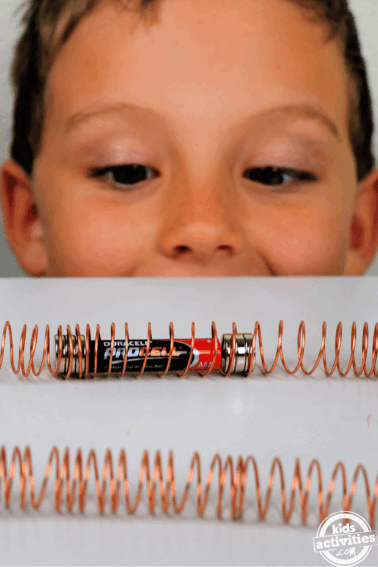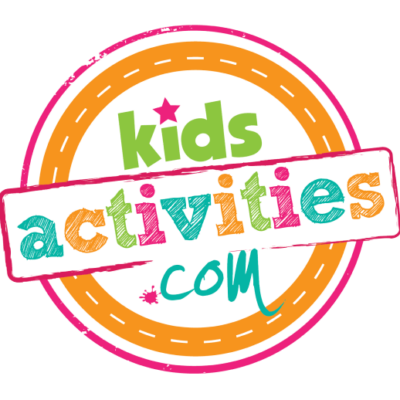Today we are doing some fun hands on activities exploring simple machines. Simple machines are tools that make our work easier by letting us push or pull things with less effort. They help us lift, move, or secure objects more easily by changing the direction or the amount of force we need to apply. When put into action, a simple machine looks more like play than work!

What is a Simple Machine?
A simple machine is a device that has a mechanism that can be used as a building block for more complicated machine. There are six types of simple machines. Each of these simple machines are things that we can build at home to lessen our “work” load:
- lever (like a seesaw)
- wheel and axle (like a doorknob)
- inclined plane (like a ramp)
- wedge (like a doorstop)
- screw (like a jar lid)
- pulley (like a flagpole)
Today we are going to concentrate on one of these simple machines: the pulley. By building a pulley together we can see all sorts of ways that pulleys can be used to help people lessen the load.
Let’s Make a Pulley
Pulleys are all about making lifting easier, and you’ll see just how with a simple setup using a rope and a wheel. By threading a rope through a wheel, you can lift objects with much less effort—a great way to show kids the power of physics in action. It’s hands-on science that demonstrates real-world applications, making the learning experience both educational and fun.
This article contains affiliate links.
Supplies Needed to Build a Pulley
- string or rope
- rolling pin
- something to lift* (a bucket works great)
*Instead of a bucket, we lifted the VERY heavy English book.

How to Build a Simple Pulley with Kids
Step 1
Start by tying your string or rope onto the item you are going to lift. If you are using a bucket or something that has a handle, then tie it onto the handle. If you are using something like we did, a book, then first tie the book across each side (like you would a package) and then attach the rope or string onto the mid point of the book in the middle.
Step 2
Have the child lift the item using the string/rope without the pulley and assess how easy or hard it is to move upward.
Step 3
THEN loop the string OVER the rolling pin and tried to lift the book again using the end of the rope/string.
Science Behind Pulleys
A pulley is a wheel on an axle that is designed to support movement of a cable or belt along its circumference. – Oxford English Dictionary
Pulleys can be used to lift weight. In the simplest terms, a pulley works because the portions of rope on either side are supporting 1/2 the weight. There are ways to cut this load even more by combining fixed pulleys, making the pulley movable, or combining fixed and movable pulleys into a compound pulley.
We weren’t too worried about the math implications of all this today, but exploring that could put numbers to something that they can experience.
Our Experience Making a Pulley
- Each boy expressed amazement at how much easier it was to lift the book with the pulley.
- They then took another 50 or so turns followed by a hunt through the house for things to practice lifting with and without our fancy pulley.
- The boys went through the house and garage looking for pulley machines at work.
- The most notable were the light fixture in our game room and a Lego pulley built into the boys’ Lego village, but the boys remembered a MUCH better pulley…

…the bucket pulley at Grandpa’s tree house.
More Science Fun for Kids from Kids ACtivities Blog
- Lift an ice cube with a string
- Gravity Experiment for Kids
- How to make a compass
- How to make a catapult
- Recycled Robot Craft
- Science fair ideas kids love
- Fun science experiments you can do at home
- Science games! <–need I say more?
- Air pressure experiment fun
- Our favorite preschool science activities
- Egg and vinegar experiment
- Build your own atom model
- Grab our fun scientific method worksheet for kids
Did you build a pulley? What did you lift? Tell us in the comments below!






















The best Model is
Paloma B.
In virtually every situation, the price of the BI system is a
big factor, and will restriction your google search to specific
segments of the marketplace. Your single most
critical aspect of cost, unfortunately, will be be sure you fully grasp the genuine
utter worth of ownership (TCO) of your solutions you
are considering. In typical BI achievements, the price of the software program is actually a tiny small
fraction of everything you should pay out. This is certainly
because a large number of BI possibilities require expensive
integration and report production services. The expense of our contacting professional services always eclipse the software program certification commissions.
In addition to this, the services required to maintain your files
and analytical applications (e.g., modifying and
also extending them to satisfy the changing requirements of your business users) and additionally create brand-new appliances also have to
be taken right into account. You are able to make the assumption that you can expect to
always require more among these services as compared to you anticipate.
I like the simplicity of this educational experiment. I am technically challenged, by the way. 🙂
Thank you so much for linking this post up in Homeschooling on the Cheap! the past week! Your link was the #1 most clicked link. I appreciate you taking time to link up and share your idea with my readers. I love reading the post on your site!
Thanks, Kelli
http://3boysandadog.com/deals/2012/homeschooling-on-the-cheap-05102012/
Ooh clever! I bet the boys were fascinated!
Thanks for sharing on Kids Get Crafty!
Maggy & Alissa
I don’t think I would have thought to use a rolling pin for a pulley, love that idea!
Thanks for linking up to Science Sunday!
Great Ideas and lots of Fun!
Excellent resource Holly! Thank you. Just in time for 2nd Grade Science at Homeschool Cooperative. Gracias!
My 9 year old will totally dig this! Thanks for the ideas!
We created our own pulley system in the preschool classroom. Students loved it. http://www.brennaphillips.com/using-a-pulley-during-construction-week-in-preschool
Thanks Brenna,
Looks like your class had a ton of fun with it!
Holly